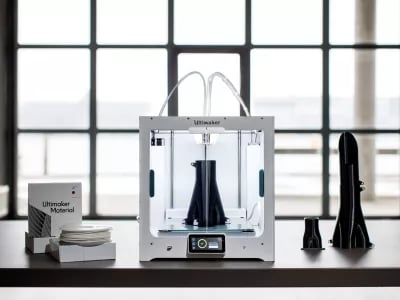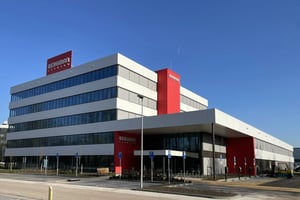For a number of years now, 3D printing has been everywhere, and it has become indispensable to industries such as automotive, aviation, manufacturing and packaging. But the disruptive technology is also increasingly used for applications that may appear less obvious but that nevertheless have a significant social impact, including education, medical services and even humanitarian emergency aid. The compact-sized, flexible and affordable desktop printers manufactured by Ultimaker – an NPM Capital portfolio company – have proved to add substantial value in unexpected settings.
Learning Braille is essential for blind and visually impaired children in order to be part of modern society, pursue an education and find a job. However, in many parts of the world modern (digital) Braille learning aids are an unattainable luxury, with a price tag attached of €1,000 or more. Many classrooms across the developing world only have access to basic, highly antiquated learning aids that make it difficult for children to gain proficiency in Braille. This is one of the causes that has made blind and visually impaired people vulnerable to social marginalisation.
It was with this concern in mind that the Indian-based designer Tania Jain, the Indian eye institute LVPEI, German manufacturer of educational toys Ravensburger, and the major international advertising agency Serviceplan Group decided to join forces. The fruit of their cooperation is Fittle, the world’s first 3D-printed Braille ‘educational puzzle’. Each puzzle consists of multiple pieces which, once linked together, form a three-dimensional object shaped like a fish, a tree, a car, a rocket, and so on. A Braille letter is printed on each piece, so that when the puzzle is finished, the Braille word for that object is spelled out in its entirety.
There is already a growing collection of ‘Fittle shapes’ available for Braille schools (currently limited to India), which can either print the puzzles themselves or order them from the Fittle organisation. These schools are using the Ultimaker 2+ for their purposes, as this model offers both the best value for money and is highly practical in its use. By way of comparison: for 10,000 dollars, a Braille school can purchase four digital Braille readers or 200 Braille books. This same investment will buy an Ultimaker 2+ and 16,000 (!) 3D-printed puzzles for use in Braille education. The Fittle organisation intends to find sponsors to be able to eventually introduce the concept to other poorer regions as well.
Defective incubators
A no less spectacular application of 3D printing is e-NABLE, an open-source platform for 3D-printed hand prosthetics for children and adults that is run completely by volunteers. The e-NABLE website contains several videos showing how parents can create fully functional prosthetics for their children using a 3D printer, right from their own home. Ultimaker is one of the main sponsors of this exceptional project.
The major advantages of 3D printing – fast, local, customised production at a low cost – have since also been discovered by organisations providing humanitarian aid. One example is the US-based non-profit Field Ready, which conducted an initial pilot project involving 3D printing following the 2014 Haiti earthquake. Field Ready currently prints large numbers of items in remote disaster areas for which there is a need at that particular time, ranging from fittings to connect discharge pipes to S-shaped hooks for hanging blood bags and from cord-clamps to gas-bottle regulators. In the Nepalese Grande International Hospital in Kathmandu, Field Ready even managed to make five (donated) incubators ready for use by reprinting the defective parts.
Also read the Ultimaker article
Moniek Jansink, Global PR Specialist at Ultimaker:
“We are indeed seeing a rapid increase in the number of applications for which 3D printing is used. This is because the technology keeps becoming more accessible and user-friendly all the time, and because it’s possible to print reliably using a growing number of materials. At Ultimaker, we’re delighted to see all these inspiring initiatives worldwide in which our 3D printers have a direct and indirect impact on the quality of life. Since we strive to make the technology as simple and reliable as possible, the creative minds and designers have more time to come up with new ideas. This results not only in new applications, but sometimes also in new, global projects.”
“There’s the example of IKEA, for example, which launched the ThisAbles project, a revolutionary line of new products which make it easy for people with special needs to use existing IKEA products. This might include a device to close curtains or a tool to lower the position of a sofa. The 3D files for these tools and devices can easily be downloaded and printed at a location near the customer. It’s available to anyone, worldwide.”
Ultimaker and education
“Ultimaker feels it’s important for 3D printing to be integrated into the classroom as well. Virtually all major technical universities worldwide have set up a lab or workshop by now where several 3D printers are available to students, who use them for their coursework. Primary and secondary schools are not too far behind. By familiarising pupils and students with the technology, they learn how objects, parts and components are structured. They are also taught how to create, evaluate and further develop prototypes, while the technology further serves as an aid for meetings and collaborative work. For students, it is easier to evaluate a tangible object than a sketch or a technical specification.”
“Ultimaker provides support, including when it comes to knowledge-sharing, and supplies educational materials that enable teachers to easily incorporate 3D printing into their classes. This will eventually prompt a growing number of people to use the technology for commendable and useful purposes. We take any feedback we receive from end users in any sector or industry very seriously.”
Mission
“Our mission is to encourage people to start applying smarter production processes and only produce objects for places where they are needed, at a time when they are needed. This means we will eventually, collectively ship fewer products across the world and will prevent excess parts and components from ending up in warehouses unused. To achieve all that, the technology needs to be simple, reliable and affordable.”













